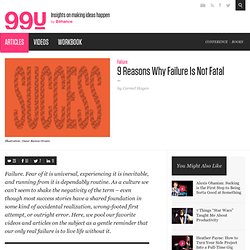

9 Reasons Why Failure Is Not Fatal. Failure.

Fear of it is universal, experiencing it is inevitable, and running from it is dependably routine. As a culture we can’t seem to shake the negativity of the term – even though most success stories have a shared foundation in some kind of accidental realization, wrong-footed first attempt, or outright error. Here, we pool our favorite videos and articles on the subject as a gentle reminder that our only real failure is to live life without it. 1. Kathryn Schulz: On Being Wrong This brief TED talk by “Wrongologist” and author Kathryn Schulz cleverly covers the inescapable error of the human mind – and the beautiful results of its imperfection. 2. The US’s bestselling vacuum isn’t just a perfect example of rethinking the norm, it’s the happy result of failure – 5,126 of them.
You once described the inventor’s life as “one of failure.” I made 5,127 prototypes of my vacuum before I got it right. Not all failures lead to solutions, though. We’re taught to do things the right way. Why You Can't Buy Creativity. “The work had better be good, I’m paying them enough.”

Over the years I’ve heard this statement – or versions of it – from many different managers charged with getting creative work out of their teams. From a conventional management perspective, it probably sounds like common sense. But to anyone who understands the nature of creativity and what motivates creative people, it’s a recipe for disaster.Rewarding people for hard work is a great thing to do, but it’s no guarantee of loyalty – and certainly no guarantee of creativity. And using rewards as an incentive – or even a threat – has been proven not to work when it comes to complex, challenging, creative work. There is a large body of research evidence – from the work of Harvard Business Professor Theresa Amabile and others – that relying on extrinsic motivations (a.k.a. rewards and punishments) has a negative impact on creativity. But when you’re focused on a reward, you’re not focused on the work itself.
Men And Women Can Love The Same Design For Different Reasons. [This is the third post in a series by Smart Design.

Click here to read the introduction, here to read the first post, and here to read the second. -- Ed.] Why not try to please all the people all the time? By and large, we should design for both men and women, and transparent design is the clear choice if a product is intended to be used by everyone. (As I discussed in my previous post, this differs from visible design, where physical differences or social needs suggest separate solutions.) But understanding gender differences may still be critical. It's our job as designers to help define a product -- from character and form to color and materials. Let's look at how this dynamic plays out in the car industry. Stay tuned for more info in my next post on how to deliver a transparent design.